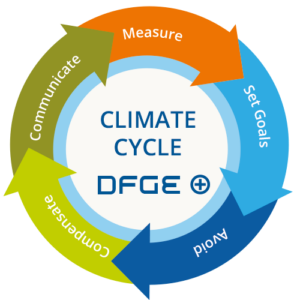Carbon Neutrality on a scientific foundation
The DFGE Climate Cycle
Determining a company’s greenhouse gas emissions (Corporate Carbon Footprint) is a central component of your corporate sustainability. In addition, you need a concrete climate target that specifies the necessary emission savings, as well as an implementation plan that includes concrete measures. Both together form your company’s framework plan and make your ambitions measurable and comparable. A science-based strategy along our DFGE Climate Cycle avoids climate change risks and exploits opportunities as they arise.
We support you as the first Science-Based Targets partner in the DACH region in accordance with international standards such as the ISO standard or the GHG Protocol. In a holistic approach, we accompany you as a full-service provider from the calculation of the carbon footprint to certification and a possible offset via climate protection projects. DFGE uses a robust scientific process methodology, rejects blanket calculations and delivers valid results.
Dr.-Ing. Thomas Fleissner
Founder & CEO of DFGE
“The greatest motivation for our customers to work carbon neutrally in parts or as a whole is to implement our corporate philosophy. This includes the fulfillment of strategic CSR goals as well as a fundamental image improvement. Increased sales or cost savings, for example through energy conservation and increased energy efficiency, go hand in hand with this, but are not the main focus. We support our customers with well-founded approaches and methods for CO2 calculation and CO2 compensation measures and thus prevent greenwashing.“
- Corporate Carbon Footprint with DFGE
- Product Carbon Footprint with DFGE
- Climate Strategy with DFGE
- Whitepaper: Climate Strategy
- PAS 2060
DFGE Carbon Neutrality Platform
As the only CDP partner of science-based targets in the DACH region, we offer you a holistic solution approach. To avoid greenwashing, the projects advanced with DFGE can be transparently tracked on our platform.

The DFGE Climate Cycle
Step 2: Set Goals
The next step is to develop an emission reduction strategy and set associated targets – for example, using Science-Based Targets.
Step 3: Avoid
In the third step, effective and sustainable methods for CO2 avoidance are developed and decided upon, which enable the customer to achieve higher energy and resource efficiency. This is done within a Climate Action Plan tailored to the individual needs of our customers and based on the results of the calculation of the carbon footprint.
Step 4: Compensate
The fourth step is to compensate for unavoidable residual emissions, e.g. by investing in forest protection and reforestation. Achieving so-called Carbon Neutrality for products or the entire company is the goal of the limate cycle process.
Step 5: Communicate
The disclosure of the achieved goals reflects the final step. Thus, the measures taken can be published through appropriate sustainability reports and the companies receive the DFGE climate neutral seal as well as the underlying certificate.
Your Advantages
From a management perspective
- Holistic and resilient process flow
- Management Summary
- Reduction of internally required resources in all process steps
- Climate protection solution from a single source – scientifically based, strategically appropriate
In search of high quality
- Calculation according to recognized standards e.g. ISO-Norm, GHG protocol, PAS 2060, SBTi criteria etc.
- Projects certified according to international standards
- Consideration of Scope 1, 2 and 3 emissions
- Identification of the CF value according to DFGE TopDown approach and reduction of the error range
Your Sustainability Management
- Projects aligned with the strategy and sustainability goals of the product/company
- Solution-oriented approach supports you in implementing the necessary measures
- Communication with DFGE seal for validated carbon neutrality
- Detailed report for your sustainability communication




